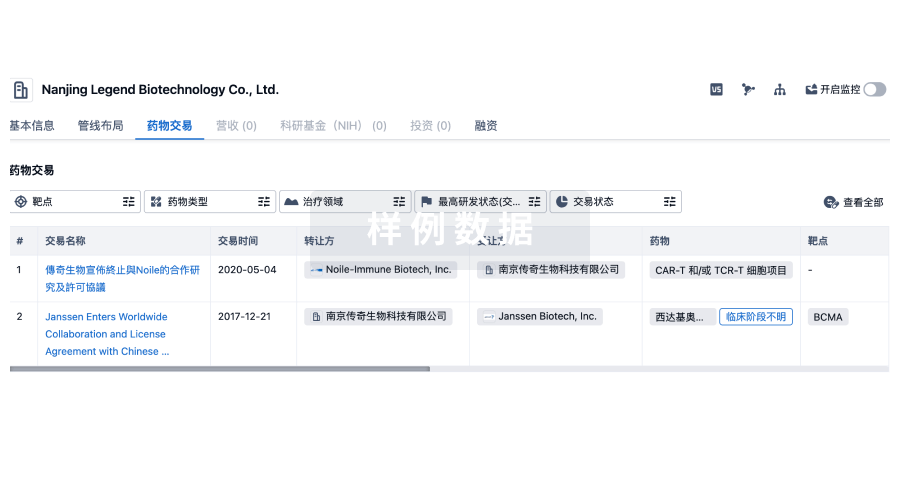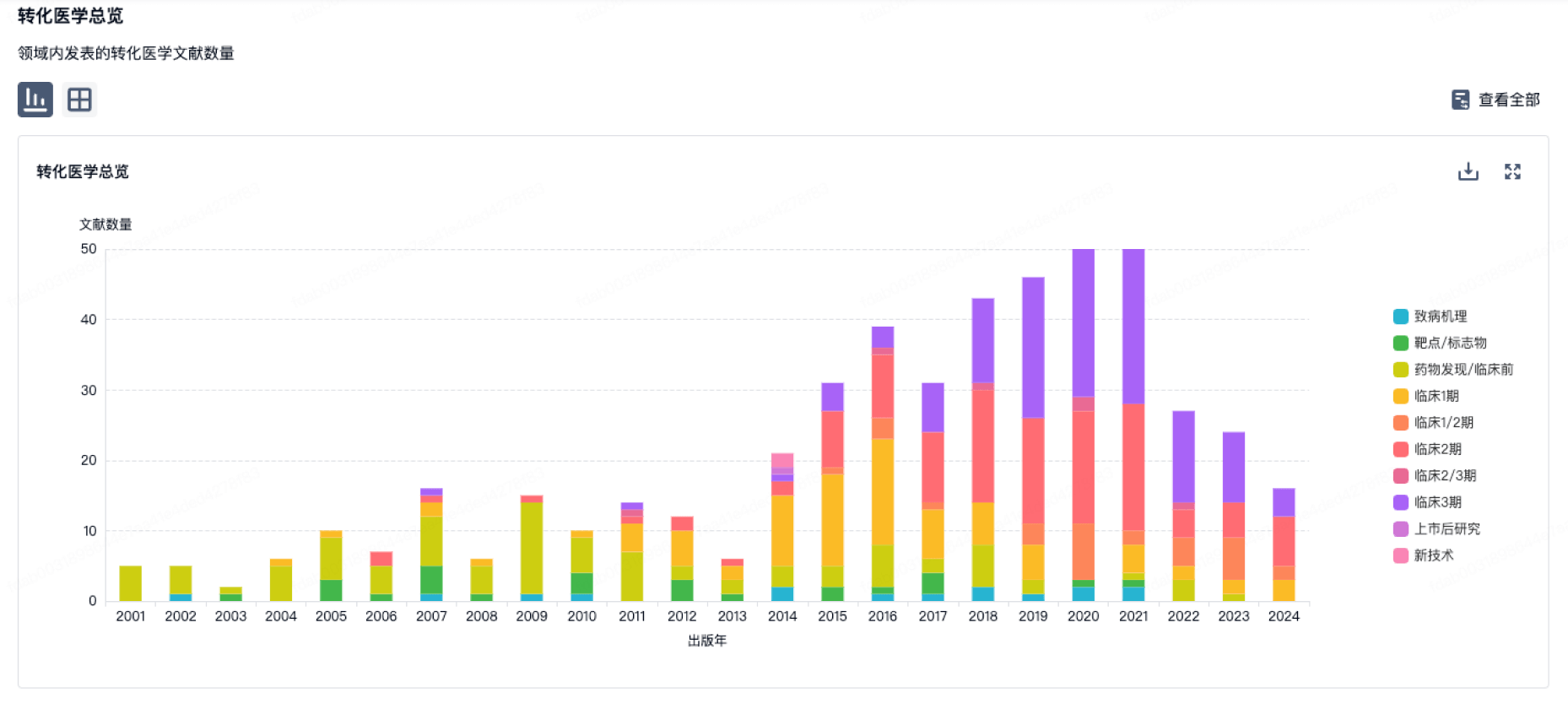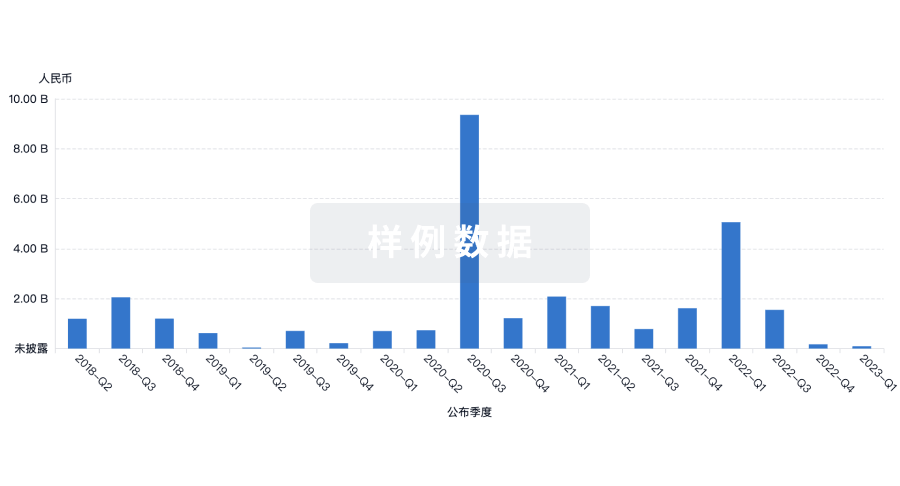预约演示
更新于:2025-12-06

Absci Corp.
更新于:2025-12-06
概览
标签
皮肤和肌肉骨骼疾病
肿瘤
消化系统疾病
单克隆抗体
小分子化药
抗体
疾病领域得分
一眼洞穿机构专注的疾病领域
暂无数据
技术平台
公司药物应用最多的技术
暂无数据
靶点
公司最常开发的靶点
暂无数据
| 排名前五的药物类型 | 数量 |
|---|---|
| 单克隆抗体 | 4 |
| 小分子化药 | 1 |
| 抗体 | 1 |
| 排名前五的靶点 | 数量 |
|---|---|
| PRLR(催乳素受体) | 1 |
| HER2(受体蛋白酪氨酸激酶 erbB-2) | 1 |
| TL1A(肿瘤坏死因子超家族成员15) | 1 |
关联
6
项与 Absci Corp. 相关的药物靶点 |
作用机制 TL1A 抑制剂 |
在研机构 |
原研机构 |
在研适应症 |
非在研适应症- |
最高研发阶段临床1期 |
首次获批国家/地区- |
首次获批日期- |
靶点 |
作用机制 HER2调节剂 |
在研机构 |
原研机构 |
在研适应症 |
非在研适应症- |
最高研发阶段临床前 |
首次获批国家/地区- |
首次获批日期- |
靶点- |
作用机制- |
在研机构 |
原研机构 |
在研适应症 |
非在研适应症- |
最高研发阶段临床前 |
首次获批国家/地区- |
首次获批日期- |
100 项与 Absci Corp. 相关的临床结果
登录后查看更多信息
0 项与 Absci Corp. 相关的专利(医药)
登录后查看更多信息
6
项与 Absci Corp. 相关的文献(医药)2024-08-09·SCIENCE
Engineered deletions of HIV replicate conditionally to reduce disease in nonhuman primates
Article
作者: Pitchai, Fathima N. Nagoor ; Keele, Brandon F. ; Pandey, Shilpi ; Busman-Sahay, Kathleen ; Burgess, William ; Khetan, Neha ; Kumar, Arjun J. ; Levrel, Clara ; Estes, Jacob D. ; Jung, Seung-Yong ; Urak, Ryan ; Weinberger, Leor S. ; Strathdee, Steffanie A. ; Glazier, Joshua ; Barnette, Philip ; Holguin, Leo ; Thompson, Cassandra ; Spencer, David ; Hessell, Ann ; Haigwood, Nancy L. ; Fennessey, Christine M. ; Harvey-Vera, Alicia ; Tanner, Elizabeth J. ; Burnett, John ; Vasen, Gustavo ; Son, Hye-In ; Ordonez, Tracy
Antiviral therapies with reduced frequencies of administration and high barriers to resistance remain a major goal. For HIV, theories have proposed that viral-deletion variants, which conditionally replicate with a basic reproductive ratio [R
0
] > 1 (termed “therapeutic interfering particles” or “TIPs”), could parasitize wild-type virus to constitute single-administration, escape-resistant antiviral therapies. We report the engineering of a TIP that, in rhesus macaques, reduces viremia of a highly pathogenic model of HIV by >3log
10
following a single intravenous injection. Animal lifespan was significantly extended, TIPs conditionally replicated and were continually detected for >6 months, and sequencing data showed no evidence of viral escape. A single TIP injection also suppressed virus replication in humanized mice and cells from persons living with HIV. These data provide proof of concept for a potential new class of single-administration antiviral therapies.
2020-10-26·Journal of chemical information and modeling
Improved Scaffold Hopping in Ligand-Based Virtual Screening Using Neural Representation Learning
Article
作者: Kalinić, Marko ; Rakočević, Goran ; Stojanović, Luka ; Tijanić, Nebojša ; Popović, Miloš
Deep learning has demonstrated significant potential in advancing state of the art in many problem domains, especially those benefiting from automated feature extraction. Yet, the methodology has seen limited adoption in the field of ligand-based virtual screening (LBVS) as traditional approaches typically require large, target-specific training sets, which limits their value in most prospective applications. Here, we report the development of a neural network architecture and a learning framework designed to yield a generally applicable tool for LBVS. Our approach uses the molecular graph as input and involves learning a representation that places compounds of similar biological profiles in close proximity within a hyperdimensional feature space; this is achieved by simultaneously leveraging historical screening data against a multitude of targets during training. Cosine distance between molecules in this space becomes a general similarity metric and can readily be used to rank order database compounds in LBVS workflows. We demonstrate the resulting model generalizes exceptionally well to compounds and targets not used in its training. In three commonly employed LBVS benchmarks, our method outperforms popular fingerprinting algorithms without the need for any target-specific training. Moreover, we show the learned representation yields superior performance in scaffold hopping tasks and is largely orthogonal to existing fingerprints. Summarily, we have developed and validated a framework for learning a molecular representation that is applicable to LBVS in a target-agnostic fashion, with as few as one query compound. Our approach can also enable organizations to generate additional value from large screening data repositories, and to this end we are making its implementation freely available at https://github.com/totient-bio/gatnn-vs.
2020-08-10·ACS Combinatorial Science
Denoising DNA Encoded Library Screens with Sparse Learning
Article
作者: Kómár, Péter ; Kalinić, Marko
DNA-encoded libraries (DELs) are large, pooled collections of compounds in which every library member is attached to a stretch of DNA encoding its complete synthetic history. DEL-based hit discovery involves affinity selection of the library against a protein of interest, whereby compounds retained by the target are subsequently identified by next-generation sequencing of the corresponding DNA tags. When analyzing the resulting data, one typically assumes that sequencing output (i.e., read counts) is proportional to the binding affinity of a given compound, thus enabling hit prioritization and elucidation of any underlying structure-activity relationships (SAR). This assumption, though, tends to be severely confounded by a number of factors, including variable reaction yields, presence of incomplete products masquerading as their intended counterparts, and sequencing noise. In practice, these confounders are often ignored, potentially contributing to low hit validation rates, and universally leading to loss of valuable information. To address this issue, we have developed a method for comprehensively denoising DEL selection outputs. Our method, dubbed "deldenoiser", is based on sparse learning and leverages inputs that are commonly available within a DEL generation and screening workflow. Using simulated and publicly available DEL affinity selection data, we show that "deldenoiser" is not only able to recover and rank true binders much more robustly than read count-based approaches but also that it yields scores, which accurately capture the underlying SAR. The proposed method can, thus, be of significant utility in hit prioritization following DEL screens.
119
项与 Absci Corp. 相关的新闻(医药)2025-12-04
Absci12月4日大涨解读关键词:AI抗体治疗启动 + 生物制药创新 + 临床试验进展1、2025年12月4日,Absci宣布其AI设计的抗体ABS-201在治疗雄激素性脱发的1/2a期HEADLINE试验中,首批健康志愿者已接受给药,标志着项目进入临床评估阶段。 2、Absci是一家利用生成式AI推进突破性抗体治疗的临床阶段生物制药公司,专注设计针对难治疗靶点如PRLR受体的疗法。(免责声明:本内容由AI技术搜集公开信息总结生成,仅供参考,不构成投资建议)
2025-12-04
当生成式AI与分子生物学碰撞,药物研发正告别“大海捞针”的传统模式。产业资本已敏锐捕捉到这一变革机遇,纷纷以战略投资、联合研发等方式加码AI制药领域,从早期技术孵化到成熟项目落地形成全链条布局。
展望2026年,资本市场对AI应用板块的预期持续升温,都在等待AI的微信红包时刻。
AI制药和AI医疗板块,因具备明确的临床价值转化路径和可观的商业回报潜力,被视为确定性的增长赛道之一。在这一产业浪潮下,紧跟产业资本的布局节奏、依托其资源与视野一同进场,不失为把握行业机遇的潜在优质路径。
如今,AI不仅能精准预测蛋白质结构、快速筛选候选化合物,更能通过数字孪生模型优化临床试验,缩短研发周期,提升研发成功率。在这一技术革命的推动下,全球跨国药企(MNC)正加速布局AI制药,2025年四季度更是掀起合作高潮,而中国本土企业也在浪潮中崭露头角,展现出强劲的发展潜力。
跨国巨头掀起AI制药合作热潮
四季度的全球医药圈,AI合作成为最耀眼的主题。礼来、默克、罗氏等行业巨头纷纷抛出重磅合作协议,合作金额屡破纪录,覆盖从靶点发现、化合物设计到临床试验、生产落地的全产业链,其中神经退行性疾病、罕见病、肿瘤等难治领域成为布局重点。
礼来在四季度构建起“AI+算力+研发”的三维合作网络。11月10日,其与英矽智能升级合作关系,借助后者Pharma.AI平台开展创新靶点的化合物研发,英矽智能最高可获逾1亿美元收益;此前的11月5日,礼来还与晶泰科技旗下Ailux达成3.45亿美元合作,聚焦双特异性抗体开发。算力支撑方面,礼来与英伟达联合打造的专属超级计算机正式落地,这台全球首个采用DGX B300系统的超级计算机,以超1000块B300 GPU提供澎湃算力,为复杂的药物研发计算提供坚实基础。
默克则以单笔超30亿美元的合作刷新行业纪录。11月20日,其与AI药企Valo达成战略合作,将借助Valo的AI生物学平台挖掘帕金森病治疗新靶点,通过闭环发现平台快速生成临床前化合物,这笔合作不仅凸显了AI在神经退行性疾病领域的应用价值,更彰显了跨国药企对AI技术的坚定信心。
罗氏、百时美施贵宝(BMS)等企业则聚焦细分领域突破。罗氏以超20亿美元牵手Manifold Bio,利用其mDesign AI平台开发能穿越血脑屏障的分子载体,解决中枢神经系统疾病药物递送难题;BMS则将与Insitro的合作升级,以超20亿美元投入肌萎缩侧索硬化症(ALS)新药研发,挖掘AI在罕见病治疗中的潜力。
赛诺菲的布局则呈现“全链条渗透”特征。10月以来,其先后与Evoq Therapeutics达成超5亿美元合作研发自身免疫病新药,与Medidata联手优化临床试验流程,还引入BenchSci的Ascend AI平台支撑临床前靶点研究。更值得关注的是,赛诺菲通过风投布局QuantHealth的临床试验模拟技术,并借助西门子与凯捷的AI方案实现生产端数字化转型,使生产报告审查效率提升70%,构建起从研发到生产的AI闭环。
诺华与阿斯利康也不甘落后。诺华与Generate:Biomedicines达成多靶点合作,以6500万美元预付款推进蛋白质疗法开发;阿斯利康则双线发力,既与Absci合作利用AI开发抗癌抗体,实现六周完成“数据收集-设计-验证”的研发闭环,又以53亿美元与石药集团联手,借助其AI平台开发免疫性疾病药物,展现出对中国AI制药技术的认可。
国内AI制药力量多点突破
国产AI制药领域正多点突破,呈现强劲发展动能。
恒瑞医药全面推进 DeepSeek 模型应用并纳入考核,搭建数字孪生等自研平台,还与 Iktos、华为等合作赋能药物研发,缩短研发周期;同时探索 AI 在临床诊疗等场景的应用。
AI技术是信达生物关注的焦点之一,信达生物新药科研机构——国清院已经广泛地应用AI在抗体设计与筛选、抗体结构和成药性预测等方面开展工作,相关布局已经取得了非常好的效果,信达生物也将在AI方向持续投资,争取能借助AI实现跨越式发展。
中国生物制药发布了AI 业务全景地图,覆盖研发、生产等 10 多个核心条线近 60 个场景。建自主可控智能知识库,在研发、生产、企业管理多环节落地 AI,还将深化应用并跨行业合作。
君实生物搭了高性能计算集群,设子公司布局 AI 软件开发,用于辅助药物研发,且靠数字员工等提升运营与合规效率。
复宏汉霖以双轮 AI 战略推进布局,搭 HAI Club 等研发平台及 HAI Hub 办公平台,与深势科技合作研发小分子药与 ADC 药,AI 技术大幅缩短候选分子筛选和透明质酸酶等产品的开发周期,还优化抗体设计与生产质控。
百奥赛图聚焦 AI 在全人抗体研发领域的应用,核心布局包括与镁伽科技合作构建 “AI + 自动化” 研发体系,整合超百万抗体分子资源与智能算法,优化抗体发现、制备及筛选全流程,提升研发效率与精准性。其 AI 驱动的基因编辑平台可为全球药企提供靶点验证服务,同时通过参与科迈生物增资,深化 AI 抗体设计赛道布局,助力 “千鼠万抗 TM” 计划数智化升级。
创新药企AI BD成果丰硕。
2025年6月13日,石药集团与阿斯利康达成53.3亿美元AI药物研发合作,核心依托石药自主研发的“AI引擎双轮驱动高效药物发现平台”,为阿斯利康开发免疫疾病等领域临床前候选药。根据协议,石药将获1.1亿美元预付款及最高52.2亿美元里程碑款,阿斯利康拥有合作药物全球独家开发、生产及商业化授权选择权。
2025年11月5日,晶泰科技全资子公司Ailux与礼来达成3.45亿美元合作,聚焦双特异性抗体开发,礼来获其AI抗体制品工程平台使用权,该平台可攻克不可成药靶点,合作含数千万美元预付款及后续里程碑款,Ailux已组建超100人团队推进。2025年8月与DoveTree达成59.9亿美元AI药物研发合作,同时以AI晶型技术为核心,与辉瑞、强生等全球药企及国内企业达成多项合作。
2025年11月10日,英矽智能与礼来升级AI研发战略合作,依托英矽智能Pharma.AI平台针对多个创新靶点联合研发,英矽智能最高可获逾1亿美元收益,涵盖首付款、里程碑付款及商业化后分级净销售额版税。此次合作明确了AI在靶点验证、化合物设计等环节的应用分工,延续了双方此前的合作基础。
2025年3约,和铂医药与阿斯利康旗下Evinova达成合作,将和铂医药Harbour Mice®全人源抗体平台、Hu-mAtrIx™ AI药物发现引擎,与Evinova的AI临床平台相融合,在北京共建创新实验室。和铂医药此前已通过类似技术体系与阿斯利康、辉瑞等企业建立合作关系。
更多上市公司积极投身AI制药浪潮:
药明康德将DEL库与AI毒性预测模型联动,实现临床前开发周期从18个月缩短至12个月;药明生物运用AI优化细胞培养工艺,同步提升生物药产能与质量;成都先导依托DNA编码化合物库与AI构建“虚拟筛选+实验验证”研发闭环;泓博医药搭建含垂直大模型的AI药物设计平台,覆盖药物设计与专利分析等功能;睿智医药将AI融入生物合成与临床CRO服务,加速研发成果转化;阳光诺和与华为云共建AI多肽分子大模型平台,推进多肽药物全流程研发。
此外,英矽智能与迈威生物、皓元医药达成ADC药物领域战略合作,以AI技术助力药物筛选与产业化;药石科技搭建基于超大化学空间的AI药物发现平台,提升早期药物筛选命中率;凯莱英将AI融入酶工程与临床研究,实现药物生产周期缩短及不良反应处理提速50%;华东医药、华润三九等也通过自主建平台或技术合作,在研发创新与绿色智造领域深化AI应用,剂泰科技、华兰股份等则在AI药物临床推进与细分赛道布局上实现突破。
结语
综上,国产AI制药已形成“传统药企加大投入+创新药企对外合作+上市公司全面布局”的格局。从恒瑞、信达的内部赋能,到晶泰、石药、英矽智能的国际合作,本土企业正以技术创新打破壁垒。政策扶持与资本加持下,国产AI制药不仅实现从“跟跑”到“并跑”的跨越,更在部分领域具备全球竞争力,为医药产业升级注入核心动力。
2025-12-03
当你还在讨论ChatGPT会不会收费时,真正改变世界的AI浪潮正在这三个领域悄然孕育。
“现在入场还有机会吗?”
当我上周在科技论坛分享AI趋势时,一个年轻创业者这样问我。他是做传统电商的,看着同行用AI工具把效率提升300%,感到了前所未有的焦虑。
我的回答是:“上一个时代的大门正在关闭,但属于AI新物种的时代才刚刚推开一条缝。”
是的,基础大模型的门槛已高到让普通人仰望,OpenAI、谷歌、Meta和几家中国巨头已经建立了护城河。但真正诞生下一个百亿独角兽的机会不在通用大模型本身,而在它们催生的应用生态。
经过对近百份行业报告、融资数据和一线创业者的调研,我发现有三个方向正积蓄着爆发式增长的能量。一、AI生命体:从“工具”到“同事”的质变
2025年,当Devin这样的AI程序员能独立完成整个项目时,我们突然意识到:AI不再是工具,而是能承担责任、自主决策的 “数字生命体”。
2026年的突破点在哪里?
AI团队化协作系统将成为关键。这不是单个AI智能体,而是由多个专业AI角色组成的虚拟团队。
想象一下:你的创业公司不需要立刻招聘产品经理、UI设计师、前端工程师、测试员。你只需要向一个AI协作平台描述你的需求:
“做一个针对自由职业者的智能财税管理App,要求界面简洁,能自动分类票据并生成税务报表。”
30分钟后,这个AI团队会给你:
一份详细的产品需求文档和原型图
一个可交互的前端界面
一个完整的后端架构和数据库设计
一套测试用例和部署方案
这个市场规模有多大?
全球有数亿中小企业,其中大部分无法负担完整的技术团队。如果每月支付500-2000美元就能拥有一个 “24小时在线的AI团队” ,这将是一个千亿美元级别的市场。
目前已有初创公司如Cognition和Magic在单点突破,但完整的AI团队协作平台仍是一片蓝海。
关键观察指标:2026年上半年,关注能够实现“AI角色互操作和协作框架”的突破。 哪个平台能率先让不同类型的AI智能体像真实团队一样无缝协作,哪个平台就会成为这个赛道的定义者。二、垂直模型工厂:让每个行业都拥有自己的“大脑”
通用大模型像百科全书,但专科医生和百科全书编纂者的价值完全不同。
2026年,“行业专属大脑” 将成为企业竞争的标配。这不是简单的API调用,而是深度融合行业知识、业务流程和私有数据的垂直AI系统。
最可能爆发的是哪几个垂直领域?
1. 生物医药AI实验室新药研发平均耗时10年、耗资20亿美元。而AI驱动的药物发现平台,能将早期研发时间从5年缩短到几个月。
一家名为Absci的公司已经展示,其AI平台能在6周内完成从靶点识别到功能性抗体设计的全过程,而传统方法需要6-18个月。
2. 工业制造的数字孪生体想象一家汽车工厂,在现实世界中生产的同时,还有一个“数字工厂”在虚拟世界中24小时不间断运行,通过AI模拟和优化每一条生产线。
西门子已经为宾利汽车打造了这样的系统,使生产效率提升了20%。2026年,这项技术将从巨头走向中型企业。
3. 个性化教育导师不是简单的“拍照解题”,而是能跟踪学生学习轨迹、识别知识盲区、动态调整教学策略的AI导师。
这类系统将掌握每个学生的“学习DNA”,实现真正的因材施教。在一个重视教育的市场,这几乎是必然的爆发点。
关键洞察:垂直领域的壁垒不是技术,而是行业Know-How和数据。 那些既懂AI又深扎行业多年的团队,最有可能在这些领域诞生独角兽。三、物理世界操作系统:当AI学会“动手”
过去几年,AI主要停留在数字世界。但2026年,我们将见证AI与物理世界的深度融合。
这不是机器人取代人类,而是 “增强型协作系统”——让人类的能力通过AI被无限放大。
最具潜力的三个应用场景:
1. AI外科医生助手2025年,约翰霍普金斯大学的研究团队已经展示了AI系统在腹腔镜手术中的自主缝合能力,精度超过人类外科医生。2026年,这类系统将开始进入临床验证阶段。
想象一下:一位县城医院的医生,通过AI辅助系统,能够完成一线城市三甲医院专家级别的手术。这不仅是医疗资源的下沉,更是医疗质量的革命。
2. 全自动化实验室生物科技和材料科学的研究严重依赖重复性实验。AI驱动的实验室机器人可以24小时不间断工作,自动设计、执行和分析实验。
一家名为Strateos的公司已经推出云端实验室,研究人员远程设计实验,机器人实体完成。这个市场的规模将在2026年突破百亿美元。
3. AI驱动的艺术与手工艺创作不只是数字艺术,而是实体艺术创作。AI设计+机器人雕刻/绘画/制造的完整流水线,将催生全新的艺术形式和产业。
潜在市场规模:全球创意产业价值超过2万亿美元,即使AI只渗透其中的10%,也是2000亿美元的市场。
核心挑战与机遇:可靠性和安全性是物理世界AI的最大门槛,也恰恰是护城河所在。 谁能率先解决AI在复杂物理环境中的稳定操作问题,谁就能定义这个领域的标准。
未来已来,你站在哪个位置?
写到这里,我想起科技作家凯文·凯利的一句话:
“未来20年最伟大的产品,现在还没被发明出来。”
这三个方向的共同点是:它们都不只是“更好的工具”,而是创造全新的价值网络和商业模式。
给不同读者的建议:
如果你是创业者:不要追逐已经过热的风口,而是审视自己的行业背景。最深的护城河往往在你已经积累了十年的领域知识中。
如果你是投资者:关注那些有交叉学科背景的团队——既懂AI技术,又深谙特定行业的痛点。
如果你是普通从业者:不要焦虑会被AI取代,而是思考如何成为AI的驾驭者和协作者。未来最稀缺的不是会使用AI的人,而是知道用AI解决什么问题的人。
2026年上半年,这三个方向中将至少有一个出现明显的突破性进展和资本聚集。
当大多数人还在讨论哪个聊天机器人更聪明时,真正的变革已经在这些深水区悄然发生。
机会从不缺少,它只是偏爱那些看得更远、想得更深的人。
你认为哪个方向会最先爆发? 在评论区留下你的观察,点赞最高的三位读者,我将送出一份包含50个最新AI工具和行业报告的资源包。
小海唠嗑:用最接地气的方式,解读最前沿的科技。下期我们聊聊“AI时代,普通人的新技能树该怎么点”。
100 项与 Absci Corp. 相关的药物交易
登录后查看更多信息
100 项与 Absci Corp. 相关的转化医学
登录后查看更多信息
组织架构
使用我们的机构树数据加速您的研究。
登录
或

管线布局
2025年12月10日管线快照
管线布局中药物为当前组织机构及其子机构作为药物机构进行统计,早期临床1期并入临床1期,临床1/2期并入临床2期,临床2/3期并入临床3期
药物发现
2
3
临床前
临床1期
1
登录后查看更多信息
当前项目
| 药物(靶点) | 适应症 | 全球最高研发状态 |
|---|---|---|
ABS-201(Absci Corp) ( PRLR ) | 雄激素脱发 更多 | 临床前 |
ABS-101 (Absci) ( TL1A ) | 炎症性肠病 更多 | 临床前 |
ABS-501 ( HER2 ) | 肿瘤 更多 | 临床前 |
ABS-301 (Absci) | 肿瘤 更多 | 临床前 |
anti-coronavirus monoclonal antibody (Ginkgo Bioworks) | 新型冠状病毒感染 更多 | 药物发现 |
登录后查看更多信息
药物交易
使用我们的药物交易数据加速您的研究。
登录
或

转化医学
使用我们的转化医学数据加速您的研究。
登录
或

营收
使用 Synapse 探索超过 36 万个组织的财务状况。
登录
或

科研基金(NIH)
访问超过 200 万项资助和基金信息,以提升您的研究之旅。
登录
或

投资
深入了解从初创企业到成熟企业的最新公司投资动态。
登录
或

融资
发掘融资趋势以验证和推进您的投资机会。
登录
或

生物医药百科问答
全新生物医药AI Agent 覆盖科研全链路,让突破性发现快人一步
立即开始免费试用!
智慧芽新药情报库是智慧芽专为生命科学人士构建的基于AI的创新药情报平台,助您全方位提升您的研发与决策效率。
立即开始数据试用!
智慧芽新药库数据也通过智慧芽数据服务平台,以API或者数据包形式对外开放,助您更加充分利用智慧芽新药情报信息。
生物序列数据库
生物药研发创新
免费使用
化学结构数据库
小分子化药研发创新
免费使用